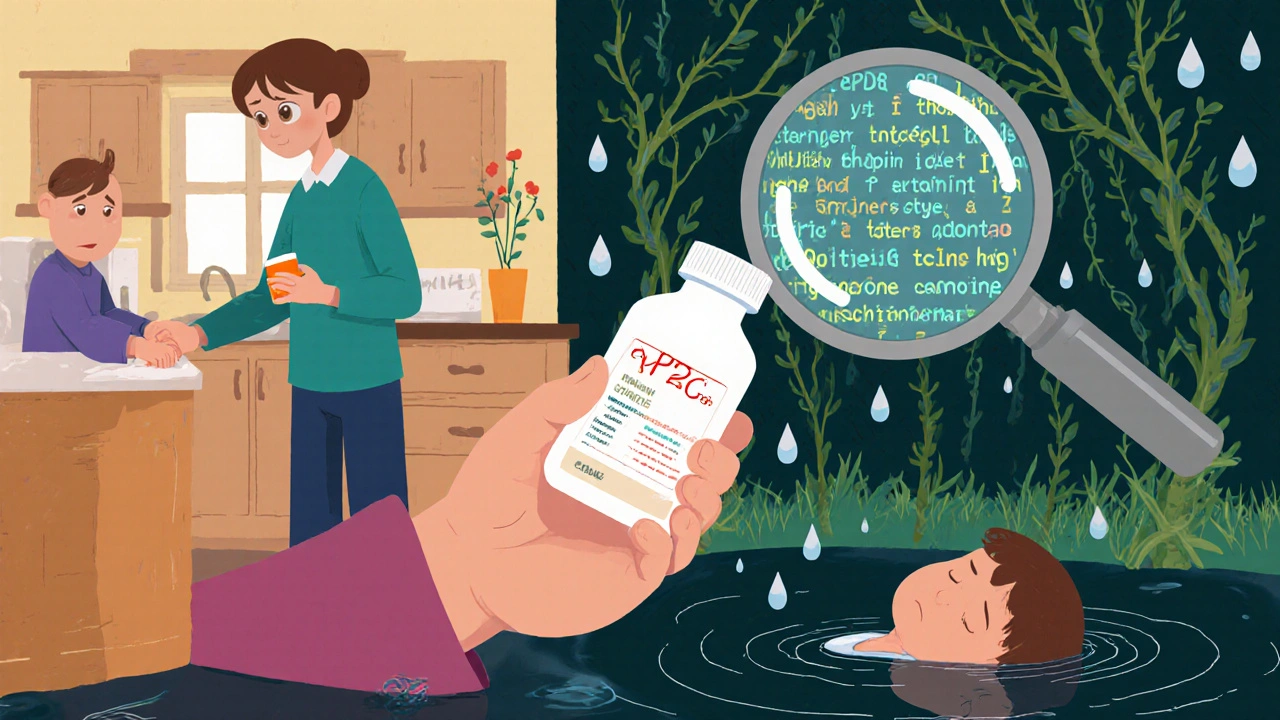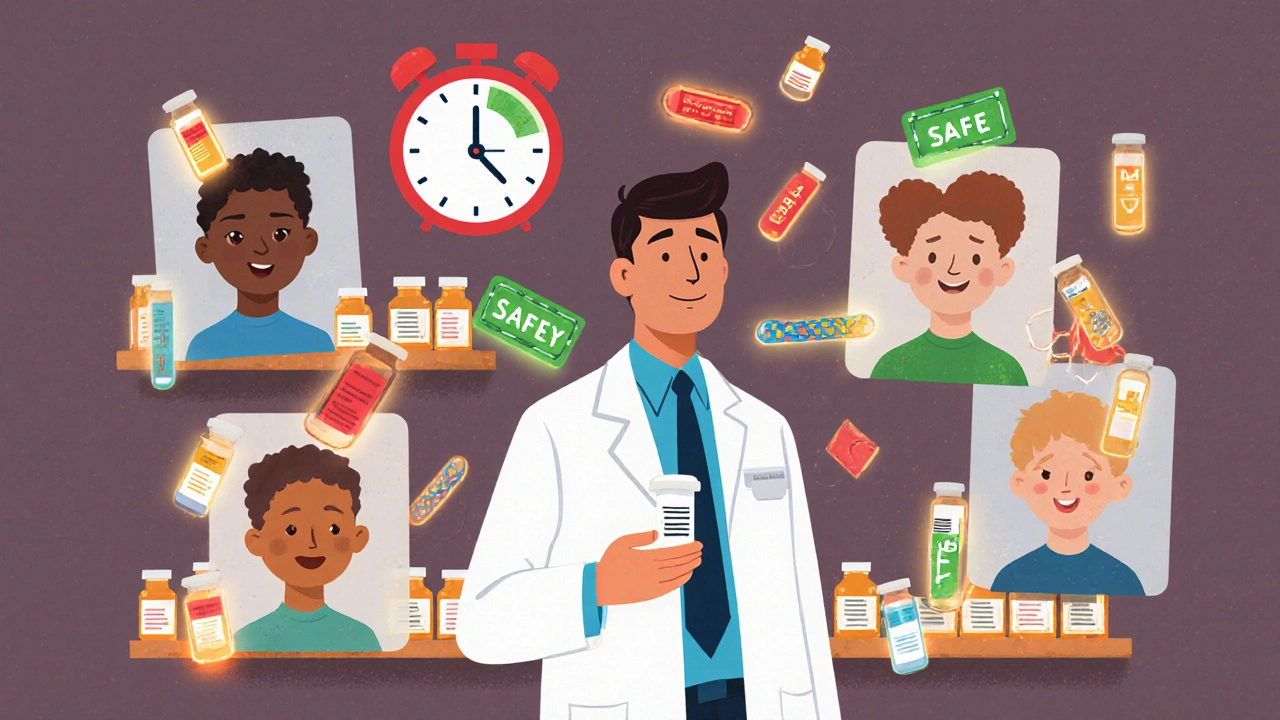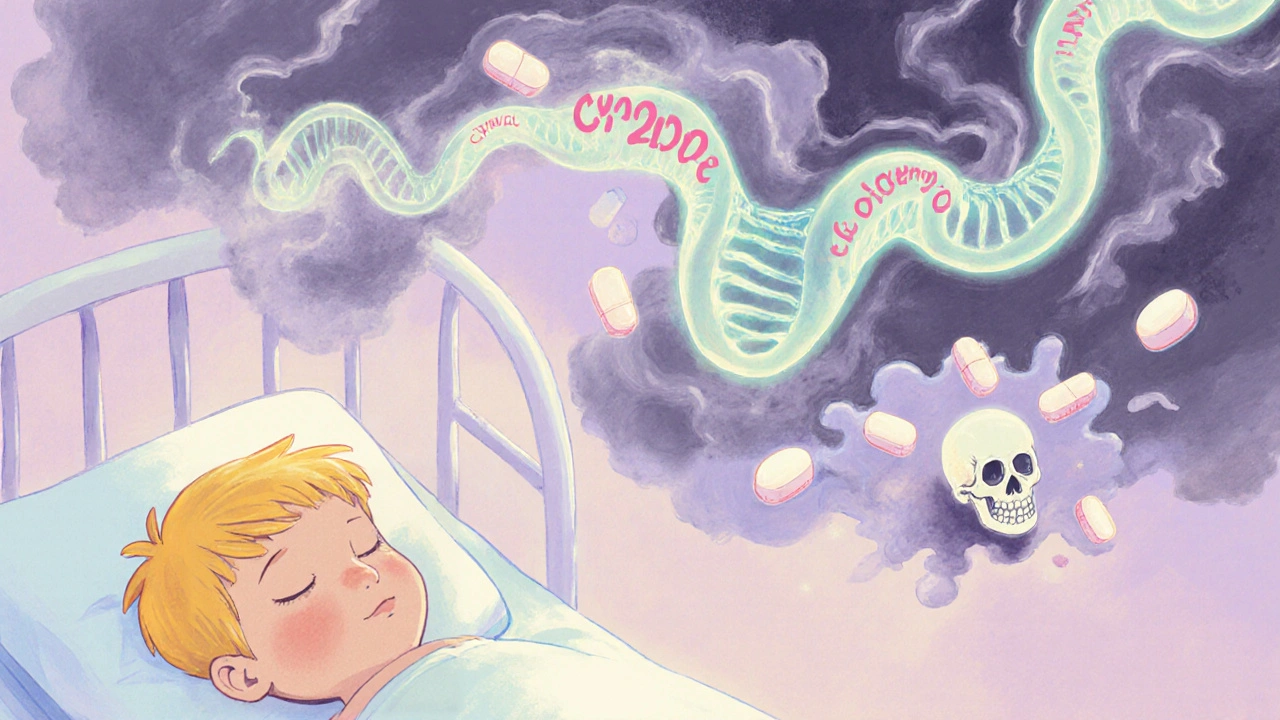CYP2D6 Ultrarapid Metabolizer Risk Calculator
Why This Matters
Codeine can be fatal for CYP2D6 ultrarapid metabolizers because their bodies convert it to morphine too quickly. This calculator estimates your risk based on ancestry and shows safety recommendations.
Your Risk Assessment
Codeine is one of the most common painkillers prescribed after minor surgeries, dental work, or for coughs. But for a small group of people, even a single dose can be deadly. It’s not because they took too much. It’s because their body turns codeine into morphine too fast - and there’s no way to know unless they’ve been genetically tested.
How Codeine Turns Into a Silent Killer
Codeine itself doesn’t relieve pain. It’s just a placeholder. Your body has to convert it into morphine to work. That conversion happens through an enzyme called CYP2D6. For most people, this process is slow and steady. But for about 1 to 7% of the population - depending on ancestry - this enzyme works at lightning speed. These are called CYP2D6 ultrarapid metabolizers. When someone with this genetic makeup takes codeine, their body turns it into morphine 3.5 to 4.5 times faster than normal. Within hours, morphine levels in their blood can spike into the toxic range. That’s when breathing slows, then stops. That’s when a child dies after a tonsillectomy. That’s when a parent gives their teenager codeine for a headache, and they never wake up. The U.S. Food and Drug Administration (FDA) issued a warning in 2013 after reviewing 64 case reports. Twenty-four people died. Twenty-one of them were children under 12. In 15 cases where blood levels were tested, 13 showed morphine concentrations far above safe limits. Post-mortem tests later confirmed that most of these children were CYP2D6 ultrarapid metabolizers.Who’s at Risk?
This isn’t random. It’s genetic. People with extra copies of the CYP2D6 gene - like *1/*1xN, *2/*2xN, or *1/*2xN - are ultrarapid metabolizers. These variants are more common in certain populations:- Up to 29% in North African and Ethiopian populations
- 3-7% in Europeans
- 3% in Australians
- 1-2% in East Asians
What Happens During an Overdose?
Symptoms don’t always come quickly. They can start as mild drowsiness, nausea, or vomiting. Then comes extreme sleepiness. The person may seem “just really tired.” But within hours, breathing becomes shallow. Lips turn blue. They stop responding. Then they stop breathing entirely. In the 10 documented cases where CYP2D6 status was confirmed after death, 7 were ultrarapid metabolizers. Five of those children died. One of them was a 15-month-old who got codeine after surgery. A post-mortem test showed morphine levels 10 times higher than the safe limit. The problem? Most people don’t know they’re ultrarapid metabolizers until it’s too late. There are no visible signs. No family history. No warning. It’s a silent genetic trap.
What Should Doctors Do?
The answer is simple: Don’t prescribe codeine to anyone unless they’ve been tested. The Clinical Pharmacogenetics Implementation Consortium (CPIC) has been clear since 2012 and updated their guidelines in 2020: “Codeine or tramadol should not be used in individuals with a CYP2D6 activity score greater than 2.25.” That’s the cutoff for ultrarapid metabolizers. For pain relief, safer alternatives exist:- Morphine (doesn’t rely on CYP2D6)
- Hydromorphone
- Fentanyl
- Non-opioid options like acetaminophen or ibuprofen
Why Isn’t Everyone Tested?
The biggest barrier isn’t science. It’s access. Genetic testing for CYP2D6 costs between $200 and $500. Insurance often doesn’t cover it unless you’ve already had a bad reaction. Most labs take 3 to 14 days to return results. In an emergency, that’s useless. Only 15-20% of major U.S. hospitals have integrated pharmacogenetic testing into their routine workflows. Most electronic health records don’t flag a patient’s CYP2D6 status. Doctors aren’t trained to ask for it. Patients don’t know to request it. There’s also a myth that “it’s rare, so why bother?” But 3% of the population isn’t rare. In a city of 500,000, that’s 15,000 people. In a hospital that sees 10,000 patients a year, you’re likely to give codeine to 300 people who shouldn’t get it.
What About Other Opioids?
Some doctors switch patients from codeine to hydrocodone or oxycodone, thinking they’re safer. But that’s a mistake. Hydrocodone turns into hydromorphone. Oxycodone turns into oxymorphone. Both of those conversions also rely on CYP2D6. So if you’re an ultrarapid metabolizer, you’re still at risk - just with a different drug. The CPIC guidelines warn against this. They specifically recommend morphine, hydromorphone, or fentanyl for patients with CYP2D6 ultrarapid metabolism. These drugs don’t need activation. They’re already active. Tramadol, another common painkiller, has the same problem. The FDA added a warning for tramadol in 2016 after 9 more pediatric deaths linked to CYP2D6 ultrarapid metabolism.What Can You Do?
If you’ve ever been prescribed codeine - or if you’re considering it for yourself or your child - ask these questions:- Is there a non-opioid option? (Acetaminophen or ibuprofen often work just as well.)
- If an opioid is needed, is it morphine, hydromorphone, or fentanyl - not codeine or tramadol?
- Has my CYP2D6 status been tested?
- If not, can we test before prescribing?
The Future Is Personalized
This isn’t just about codeine. It’s about how medicine is changing. We’re moving from “one-size-fits-all” to “right drug, right dose, right person.” Research is underway to make CYP2D6 testing faster. A $2.5 million NIH study at Vanderbilt University is testing point-of-care machines that could give results in under two hours. That means in the ER, a child could get tested before getting pain meds. Dr. Mary Relling of St. Jude Children’s Research Hospital predicts codeine will become a drug of historical interest within the next decade. She’s not exaggerating. With better testing, better guidelines, and better awareness, codeine’s days are numbered. For now, the message is clear: If you’re prescribing or taking codeine, don’t assume it’s safe. Ask the genetic question. Because sometimes, the difference between relief and death is a single gene.Can codeine be safe for children?
No. The FDA, American Academy of Pediatrics, and European Medicines Agency all warn against using codeine in children under 12. Even at standard doses, children who are CYP2D6 ultrarapid metabolizers can develop fatal respiratory depression. Safer alternatives like acetaminophen, ibuprofen, or morphine should always be used instead.
How do I know if I’m a CYP2D6 ultrarapid metabolizer?
You need a genetic test that analyzes your CYP2D6 gene. This is typically done through a blood or saliva sample. The test looks for extra copies of the gene that cause ultra-rapid enzyme activity. Results are reported as an activity score - above 2.25 means ultrarapid metabolizer. Talk to your doctor about ordering the test before starting any opioid that relies on CYP2D6 metabolism.
Are there side effects of CYP2D6 testing?
No. The test itself is harmless - it’s just a blood draw or cheek swab. There are no physical side effects. The main risks are emotional or financial: anxiety about results, or out-of-pocket costs if insurance doesn’t cover it. But the benefit - avoiding a potentially fatal overdose - far outweighs these concerns.
If I’m an ultrarapid metabolizer, does that mean I can never take opioids?
No. You can still take opioids safely - just not codeine or tramadol. Morphine, hydromorphone, and fentanyl are fully active drugs and don’t rely on CYP2D6. Your doctor can adjust the dose based on your needs. Many people with this genetic profile manage chronic pain effectively with these alternatives.
Why isn’t CYP2D6 testing done routinely before prescribing?
Because it’s not yet standard practice. Most clinics don’t have the infrastructure, and insurance often doesn’t cover it without prior authorization. Doctors aren’t always trained in pharmacogenetics. But as testing becomes cheaper and faster - with point-of-care devices on the horizon - this is changing. For now, if you’re at risk or have had a bad reaction, ask for the test.
